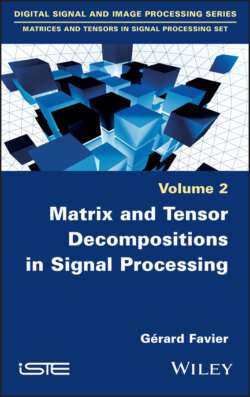Читать книгу Matrix and Tensor Decompositions in Signal Processing - Gérard Favier - Страница 16
I.6. Brief description of content
ОглавлениеTensor operations and decompositions often use matrix tools, so we will begin by reviewing some matrix decompositions in Chapter 1, going into further detail on eigenvalue decomposition (EVD) and SVD, as well as a few of their applications.
The Hadamard, Kronecker and Khatri–Rao matrix products are presented in detail in Chapter 2, together with many of their properties and a few relations between them. To illustrate these operations, we will use them to represent first-order partial derivatives of a function, and solve matrix equations, such as Sylvester and Lyapunov ones. This chapter also introduces an index convention that is very useful for tensor computations. This convention, which generalizes Einstein’s summation convention (Pollock 2011), will be used to represent various matrix products and to prove some matrix product vectorization formulae, as well as various relations between the Kronecker, Khatri-Rao and Hadamard products. It will be used in Chapter 3 for tensor matricization and vectorization in an original way, as well as in Chapter 5 to establish matrix forms of the Tucker and PARAFAC decompositions.
Chapter 3 presents various sets of tensors before introducing the notions of matrix and tensor slices and of mode combination on which reshaping operations are based. The key tensor operations listed above are then presented. Several links between products of tensors and systems of tensor equations are also outlined, and some of these systems are solved with the least squares method.
Chapter 4 is dedicated to introducing the notions of eigenvalue and singular value for tensors. The problem of the best rank-one approximation of a tensor is also considered.
In Chapter 5, we will give a detailed presentation of various tensor decompositions, with a particular focus on the basic Tucker and CPD decompositions, which can be viewed as generalizations of matrix SVD to tensors of order greater than two. Block tensor models and constrained tensor models will also be described, as well as certain variants, such as HOSVD and BTD (block term decomposition). CPD-type decompositions are generally used to estimate latent parameters, whereas Tucker decomposition is often used to estimate modal subspaces and reduce the dimensionality via low multilinear rank approximation and truncated HOSVD.
A description of the ALS algorithm for parameter estimation of PARAFAC models will also be given. The uniqueness properties of the Tucker and CDP decompositions will be presented, as well as the various notions of the rank of a tensor. The chapter will end with illustrations of BTD and CPD decompositions for the tensor modeling of multidimensional harmonics, the problem of source separation in an instantaneous linear mixture and the modeling and estimation of a finite impulse response (FIR) linear system, using a tensor of fourth-order cumulants of the system output.
High-order cumulants of random signals that can be viewed as tensors play a central role in various signal processing applications, as illustrated in Chapter 5. This motivated us to include an Appendix to present a brief overview of some basic results concerning the higher order statistics (HOS) of random signals, with two applications to the HOS-based estimation of a linear time-invariant system and a homogeneous quadratic system.
1 1 Scalars, vectors, and matrices are written in lowercase, bold lowercase, and bold uppercase letters, respectively: a, a, A.
2 2 A decomposition satisfies the essential uniqueness property if it is unique up to permutation and scaling factors in the columns of its factor matrices.
3 3 Big data is characterized by 3Vs (Volume, Variety, Velocity) linked to the size of the data set, the heterogeneity of the data and the rate at which it is captured, stored and processed.
4 4 Electroencephalography (EEG), magnetoencephalography (MEG), electrocardiography (ECG) and electrooculography (EOG).
5 5 PARAFAC for parallel factors; CANDECOMP for canonical decomposition; CPD for canonical polyadic decomposition; TD for Tucker decomposition; TT for tensor train.
